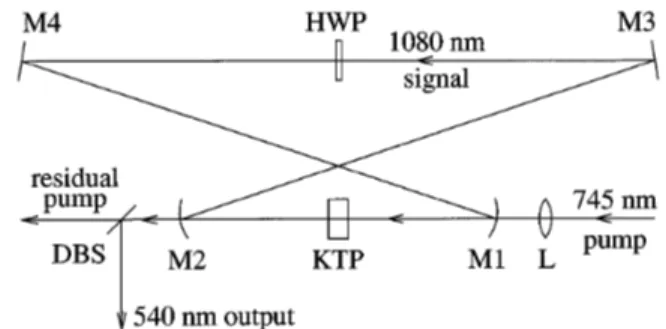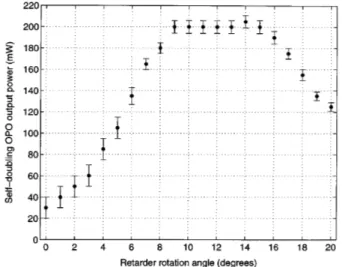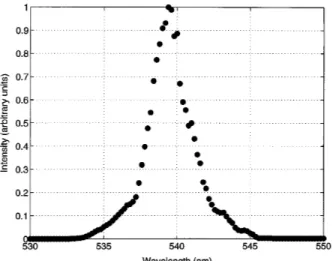280 OPTICS LETTERS / Vol. 22, No. 5 / March 1, 1997
Phase-matched self-doubling optical parametric oscillator
Tolga Kartaloˇglu, Kahraman G. K ¨opr ¨ul ¨u, and Orhan Ayt ¨urDepartment of Electrical and Electronics Engineering, Bilkent University, TR-06533 Bilkent, Ankara, Turkey
Received October 30, 1996
We report a synchronously pumped intracavity frequency-doubled optical parametric oscillator that employs a single KTiOPO4crystal for both parametric generation and frequency doubling. Both nonlinear processes are
phase matched for the same direction of propagation in the crystal. The parametric oscillator, pumped by a femtosecond Ti:sapphire laser at a wavelength of 745 nm, generates a green output beam at 540 nm with a 29% power conversion efficiency. Angle tuning in conjunction with pump wavelength tuning provides output tunability in the 530 – 585-nm range. 1997 Optical Society of America
Frequency conversion using synchronously pumped op-tical parametric oscillators (OPO’s) is a widely used technique for extending the wavelength range of ul-trafast laser systems to longer wavelengths.1
Dye, Ti:sapphire, and various Nd lasers have been used successfully to pump OPO’s based on a variety of nonlinear crystals. In addition, the use of a second nonlinear crystal inside the OPO cavity has facili-tated upconversion to shorter wavelengths by intra-cavity second-harmonic generation2 – 4 (SHG) and by
sum-frequency generation.5
OPO’s that are pumped by frequency-doubled lasers have also been used to this end.6
Non-phase-matched SHG and sum-frequency generation processes of various OPO beams are com-monly observed in OPO’s.4,7 – 10
The beams that result from these processes usually have low power because of the non-phase-matched nature of the interactions. The power conversion eff iciency of these interactions has been limited to a few percent at best.7
In this Letter we report a phase-matched self-doubling OPO in which a single nonlinear crystal is employed for both parametric generation and fre-quency doubling. Our self-doubling OPO is based on a KTiOPO4(KTP) crystal that is synchronously pumped by a Ti:sapphire laser operating at a wavelength of 745 nm. When it is pumped at this wavelength, the KTP crystal is phase matched for parametric genera-tion at a signal wavelength of 1080 nm, corresponding to an idler wavelength of 2400 nm. The singly reso-nant OPO cavity consists of highly ref lecting mirrors at the signal wavelength. The signal beam is also phase matched for SHG at the same crystal orien-tation. With proper intracavity polarization rotation, a frequency-doubled output beam at a wavelength of 540 nm is generated. To our knowledge, this is the first demonstration of phase-matched optical paramet-ric oscillation and frequency doubling within a single crystal.
In our experiments we use a 5-mm-long KTP crystal that is cut for noncritical phase matchingsu 90±, f u±d. Parametric generation is phase matched in a type II geometry in which the pump at 745 nm and the signal at 1080 nm are both p polarized (horizontal, fast crystal axis), and the idler at 2400 nm is s polar-ized (vertical, slow crystal axis). Frequency doubling is also phase matched for the same direction of
propa-gation in a type II geometry in which the fundamental at 1080 nm is 45±polarized and the second harmonic at 540 nm is p polarized. The crystal has antiref lection coatings for the signal wavelength (1080 nm) on both surfaces, the pump wavelength (745 nm) on the input surface, and the second-harmonic wavelength (540 nm) on the output surface.
A mode-locked Ti:sapphire laser (Coherent, Mira 900F) provides the pump beam to the OPO at a wavelength of 745 nm. The nearly transform-limited pump pulses are 150 fs in duration (225-fs autocor-relation) and have a repetition rate of 76 MHz. We constructed a ring cavity consisting of four mirrors that are high ref lectors at 1080 nm, as shown in Fig. 1. Mirrors M1 and M2 are 100-mm radius-of-curvature concave, and M3 and M4 are f lat. The KTP crystal is positioned at the intracavity focus between M1 and M2. The pump beam is focused with a lens (L) of focal length 50 mm and enters the cavity through M1, which has high-transmission coatings for this pur-pose. (The pump beam experiences a total loss of 3% from propagating through L and M1.) The lowest-order transverse mode of the cavity has a 30-mm di-ameter (calculated), and the focused pump beam has a 60-mm diameter (measured) at the crystal. For effi-cient frequency doubling a half-wave retarder (HWP) at 1080 nm is placed inside the OPO cavity, which couples some of the p-polarized signal beam to s po-larization. We adjust the length of the cavity manu-ally by moving M3 to synchronize the intracavity signal pulses with the pump pulses. The frequency-doubled
Fig. 1. Self-doubling OPO setup. The pump beam is provided by a mode-locked Ti:sapphire laser that has 150-fs-long pulses at a repetition rate of 76 MHz.
March 1, 1997 / Vol. 22, No. 5 / OPTICS LETTERS 281
green beam at 540 nm exits the cavity through M2, which has high-transmission coatings for this purpose. This optic is also transparent to the idler wavelength at 2400 nm. A dichroic beam splitter (DBS) separates the output green beam from the residual pump beam and the generated idler beam. The diverging output beam is collimated with a lens (not shown). (The green beam experiences a total loss of 9% propagat-ing through M2, L, and DBS.) In addition, the rela-tively weak 1080-nm beam coming out through M3 owing to the slightly lower than unity ref lectivity of the mirror is used to probe the intracavity signal power and polarization.
When the half-wave retarder is not in the cavity or when its fast and slow axes are aligned with those of the crystal, we observe little frequency doubling. Because in this case the intracavity signal beam has no s-polarized component, phase-matched type II SHG cannot take place. The result is a severely undercoupled OPO cavity for the signal beam. The threshold of this OPO is 25 mW (measured pump power before the lens). At an input pump power of 700 mW the pump beam is depleted by 62%, showing strong parametric conversion. Under these conditions the weak signal output from M3 is 45 mW.
We achieved intracavity frequency doubling by ro-tating the retarder and hence roro-tating the intracavity signal polarization. Doing this couples a portion of the p-polarized signal beam to s polarization, allowing SHG to take place in the KTP crystal. At each pass through the crystal the p-polarized signal beam expe-riences gain that is due to parametric amplification and, at the same time, (nonlinear) loss that is due to SHG. In addition, the linear loss experienced by the
p-polarized signal beam is increased with the polar-ization rotation of the retarder, increasing the OPO threshold. The s-polarized component in the cavity is depleted by the SHG process at the output of the crys-tal. Figure 2 shows the 540-nm green output power from the self-doubling OPO as a function of retarder rotation angle for a pump power of 700 mW. A maxi-mum of 205-mW green output power is obtained at a retarder rotation angle of 14±. For this retarder position the conversion efficiency of the input pump power to the output green power is 29%, and the pump depletion is 71%. The 1080-nm signal output from M3 drops to 11 mW at this point. Because two 745-nm photons are used to create one 540-nm photon, the quantum-limited performance11
for the self-doubling OPO is given by the number of output 540-nm pho-tons divided by twice the number of input 745-nm photons. (Full conversion yields a quantum-limited performance of 100%.) Our 29% power conversion efficiency corresponds to a quantum-limited per-formance of 42%. When the extra losses incurred by the pump at the input [L and M1 (Fig. 1)] and by the green at the output (M2, L, and DBS) are taken into account, we deduce a power conversion efficiency of 34% and a quantum-limited performance of 48%. Figure 3 shows the green output power as a function of input pump power. The threshold of the OPO is 85 mW. The retarder angle at each input pump power is not optimized to yield the maximum
green output power there but is kept constant at 14±. As a result, the threshold is higher than in the case when the retarder angle is 0±.
The spectrum of the green output beam as measured by a monochromator is shown in Fig. 4. The output spectrum is narrower than those of the pump and the intracavity signal. The autocorrelation width of the green pulses is 480 fs. The autocorrelation width of the weak signal pulses from M3 is 415 fs. This pulse broadening is due to group-velocity mismatch in the crystal3
and is an important shortcoming of our experiment. We expect to correct this problem with the use of a shorter crystal. The use of intracavity dispersion-compression prisms may also be necessary to decrease the pulse duration further. In such a dispersion-compensation scheme the prisms should be located before the intracavity retarder, so the p-polarized signal experiences little extra loss. The beam prof ile of the green OPO output is measured with a beam prof iler to be nearly Gaussian.
It is possible to tune the self-doubling OPO by vary-ing the wavelength of the pump beam in conjunction
Fig. 2. Self-doubling OPO output power at 540 nm as a function of retarder rotation angle.
Fig. 3. Self-doubling OPO output power at 540-nm as a function of input pump power while the retarder rotation angle is held f ixed at 14±.
282 OPTICS LETTERS / Vol. 22, No. 5 / March 1, 1997
Fig. 4. Spectrum of the self-doubling OPO output at 540 nm.
Fig. 5. Calculated tuning curves for the self-doubling OPO. Angles are internal to the crystal. The f illed circles represent experimental data points.
with the crystal angles. Calculated tuning curves for the self-doubling OPO are shown in Fig. 5 together with experimental data points. By varying u in the 90±–60±range (f 0±) and the pump wavelength in the 745 – 755-nm range, one can generate frequency-doubled output between 540 and 664 nm. Changing f from 0± to 30± (u 90±) and the pump wave-length from 745 to 739 nm, one can get 540–529-nm frequency-doubled output. Experimentally, we were able to demonstrate tunability in the 530–585-nm range, currently being limited at high incidence angles by ref lection losses from the crystal surfaces and me-chanical constraints. The relatively long crystal poses a number of minor inconveniences in tuning. Rotating
the crystal not only changes the optical cavity length but also shifts the beams laterally. We can easily com-pensate for these effects by translating M3 and slightly realigning M2. The size of the transverse cavity mode and hence its overlap with the pump is strongly in-f luenced by the distance between M1 and M2, which also has to be readjusted after a rotation of the crystal. The use of a shorter crystal should decrease the sen-sitivity of the cavity to crystal rotation. On the other hand, the self-doubling OPO is only slightly sensitive to the pump wavelength. It is possible to tune the pump wavelength by several nanometers and still get a frequency-doubled output beam, which we can then maximize by rotating the crystal and making minor adjustments to the cavity.
In conclusion, we have demonstrated a self-doubling OPO that employs a single nonlinear crystal for both parametric generation and frequency doubling. The two-step conversion from the pump wavelength to the second-harmonic of the signal wavelength is highly ef-ficient, since both nonlinear conversion processes are phase matched in the same crystal. To our knowl-edge, our conversion efficiency from the pump to the second harmonic is the highest value reported to date for a frequency-doubled OPO. The self-doubling OPO provides a new and eff icient scheme for frequency upconversion of lasers. Extending this idea to other processes such as sum-frequency generation is pos-sible. Frequency upconversion of high-repetition-rate ultrafast lasers may be possible with monolithic self-doubling OPO’s.
This research was supported in part by the Turkish Scientif ic and Technical Research Council (Tubitak) under grant EEEAG-118 and by NATO’s Scientif ic Affairs Division under grant TU-MIMIC.
References
1. Feature on optical parametric oscillators and ampli-f iers, J. Opt. Soc. Am. B 10, 2148 –2243 (1993). 2. R. J. Ellingson and C. L. Tang, Opt. Lett. 18, 438
(1993).
3. D. T. Reid, M. Ebrahimzadeh, and W. Sibbett, J. Opt. Soc. Am. B 12, 1157 (1995).
4. A. Shirakawa, H. W. Mao, and T. Kobayashi, Opt. Commun. 123, 121 (1996).
5. E. C. Cheung, K. Koch, and G. T. Moore, Opt. Lett. 19, 1967 (1994).
6. T. J. Driscoll, G. M. Gale, and F. Hache, Opt. Commun. 110, 638 (1994).
7. W. S. Pelouch, P. E. Powers, and C. L. Tang, Opt. Lett. 17, 1070 (1992).
8. P. E. Powers, R. J. Ellingson, W. S. Pelouch, and C. L. Tang, J. Opt. Soc. Am. B 10, 2162 (1993).
9. Q. Fu, G. Mak, and H. M. Van Driel, Opt. Lett. 17, 1006 (1992).
10. J. M. Dudley, D. T. Ried, M. Ebrahimzadeh, and W. Sibbett, Opt. Commun. 104, 419 (1994).


